1897 – 1935
Also known as Omar and Edison
By the end of the 19th century, steamships were developing at a rapid pace. Sailing masts gave away for an ever-increasing number of funnels and the paddle wheel gave way to the much more efficient propeller. One of the first true, large steamships was the famous Great Eastern of 1860. She was over two-hundred metres long and sported five funnels along with paddle wheels plus one single screw. This ship was way ahead of its time, but as the 20th century grew closer, the average ship became more and more similar to the Great Eastern.
In the late 1880s, the British White Star Line had commissioned the first of two large liners that was to wrest the Blue Riband out of their rival Cunard’s hands. They were the Teutonic and the Majestic. Both had a gross tonnage of more than 9,000 and that gave them the distinction of being the largest ships in the White Star fleet, as well as a place among the world’s largest vessels.
In August 1889, the German Kaiser Wilhelm II attended and inspected the Spithead Naval Review together with the British Prince of Wales. Among the vessels the Kaiser especially liked one of them. It was the Teutonic the Kaiser had spotted. Knowing the present situation for the German Merchant Fleet all too well, the German sovereign is said to have uttered: ‘We must have some of these.’ Back in Germany, the Kaiser saw to that the two existing German shipping lines – Hamburg-Amerika (HAPAG) and Norddeutscher Lloyd – invested money in creating the best liners on the North Atlantic.
The first German ship to exceed the 10,000 gross ton mark was the Norddeutscher Lloyd liner Friedrich der Grosse who entered service in 1896. She was the first of a class of eleven ships, called the Barbarossa-class after the second ship. Norddeutscher Lloyd named their ships after German royalties and the third of the class was to be called Königin Luise. She would roughly be of the same size as her two earlier sisters and just as them, the Königin Luise would sport two funnels.
The Königin Luise was laid down at the Vulcan Shipyard in Stettin, Northern Germany. She was launched on October 17, 1896. She then had her quadruple expansion engines, 8,000-horsepower strong, installed and geared to the twin screws. When completed the Königin Luise would be able to speed on at 14.5 knots. After the fitting out was completed on March 16, 1897, the new ship set out on her maiden voyage between Bremerhaven and New York on March 22.
The Königin Luise was certainly not the speed queen of the North Atlantic. That honour still belonged to the Cunard Line’s Lucania, but as Norddeutscher Lloyd had constructed the famous Kaiser Wilhelm der Grosse almost simultaneously as the Königin Luise, the new four-stacker would not be long in snatching the Blue Riband from Cunard. Of course, all eyes were by 1897 set on the Kaiser Wilhelm der Grosse, but the Königin Luise still entered service with distinction. Her designers had not yet come to the stage of ornament orgies as on later German liners, and the restrained interiors of the Königin Luise made success.
With the massive emigration to Australia from Europe in mind, the Königin Luise was not only used on the North Atlantic. She had been built as a ship capable of steaming between Europe and Australia as well. Until 1902 many emigrants enjoyed the voyage to either America or Australia on board the Königin Luise. Then she was temporarily withdrawn from service in order to go through a minor refit back in Germany. When the liner returned to service again later the same year she was 145 gross tons larger, with the impressive figure of 10,711 gross tons.
The emigration to Australia had been at its peak during the 19th century, but as time advanced into the 20th century, more and more emigrants chose the Americas instead. Of course Norddeutscher Lloyd did not want to continue to run the Königin Luise on a loss-making route to Australia, so by 1904 she was removed from this service. From then on she sailed between the Mediterranean and New York.
In 1910, at the age of thirteen, the Königin Luise carried through one of her most heroic achievements. The much smaller British sailing vessel Harvard Queen had had an accident and was sinking into the ocean. The Königin Luise managed to reach the wounded ship and rescue 19 men.
Three years later, the Königin Luise went through yet another refit in Germany. New ships such as Lusitania, Mauretania, Olympic and for that matter Imperator had set new standards on the North Atlantic and in order to make the Königin Luise even more comfortable and attractive for passengers new sections were added. When the liner returned to service later that year she had a gross tonnage of 10,785.
In 1914 the First World War was ignited with the shots in Sarajevo. The German Kaiser Wilhelm II had declared war on Great Britain and her allies. The conflict required massive support from not only the military, but also – for example – the merchant fleet. At the beginning of the war most liners were converted into cruisers, patrolling the seas. But when it was realised that the liners were about to devour the world’s entire coal supplies, they were instead assigned to more appropriate duties, as troop ships. Before the Kaiser Wilhelm der Grosse had any opportunity to be converted into a troop ship she was scuttled after a heavy battle with the British cruiser HMS Highflyer. The war was indeed starting to claim its victims.
The Königin Luise was also to become a victim, but not in the same way. Her war duties had not been of the busiest kind, and immediately after Germany’s surrender in 1918 she was handed over to Great Britain as a war prize. Her new owners were the Orient SN Company who managed her for the Shipping Controller. For some reason, the British owners did not rename the Königin Luise who kept her original name. On September 4, 1920, the Königin Luise made her first voyage for the Orient SN Company. It started out from London and the goal was an old acquaintance – Australia. But before the ship reached her destination she suffered a severe accident in Lisbon, Portugal. The Königin Luise accidentally collided with the British steamship Loughborough who sank immediately. The British had completed a refit before the liner entered service and on this ‘maiden voyage’ the Königin Luise was 11,103 gross tons large.
The following year the Orient SN Company bought the Königin Luise wholly, and did not have to answer to the Shipping Controller anymore. When they were no longer in the game, Orient SN decided to rename the Königin Luise at last. The twelve letters on the ship’s bow was removed – perhaps the Ö was reused as an O – and replaced with Omar.
The Omar stayed with the Orient SN Company until 1924 when she was sold to the Byron SS company which was located in London. They renamed the Omar once again, this time to Edison after the famous inventor. The Edison would steam between Piraeus and New York in the Byron SS service. The Edison stayed with this line for many years, but in 1929 she was transferred to the National SN Company of Greece, which was an associate to Byron SS. The former Königin Luise lived a charming life in this guise until evidence of her age began to show in 1935. Her last voyage was to Italy where she was broken up the same year.
Specifications
- 552 feet (168.6 m) long
- 60 feet (18.3 m) wide
- 10,566 gross tons
- Quadruple expansion engines powering two propellers
- 14.5 knot service speed
- Passenger capacity of 2,400 people

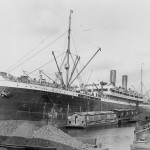
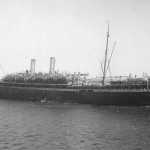
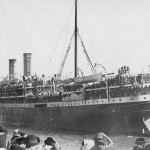
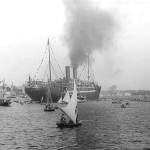
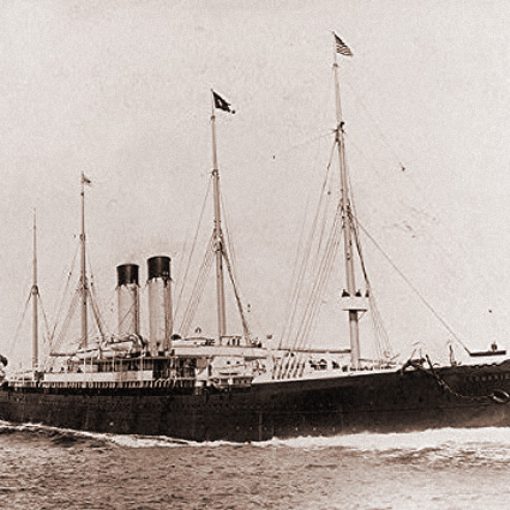
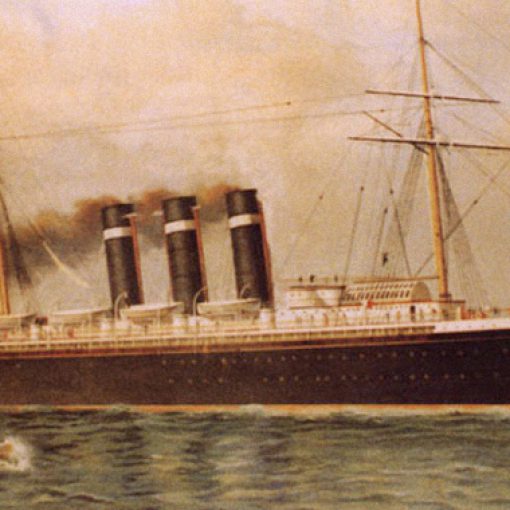
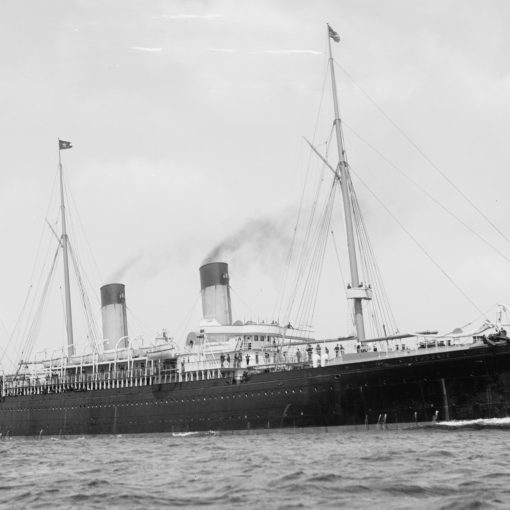
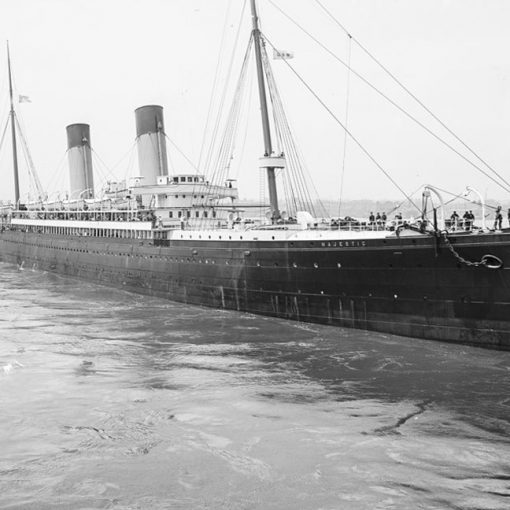
2 thoughts on “Königin Luise”
My great grand mother & great grandfather with their 7 children came to New York from Lower Austria on the Konigin Luise. They arrived in 1899. This is a very interesting history of the ship they traveled.
I have a Kaiser Whillham scarf of the Königin Luise which was converted to a landmine ship prior to the begining of the first ww1 in 1914. The Königin Luise was the first ship sunk 5 th August 1914 at the begining of the first ww1. The Königin Luise was fired upon by the British Navy at 11:00 by the ship Lance the German ship rolled over and sank. the two British Navy destroyers rescued 43 German Crewman.